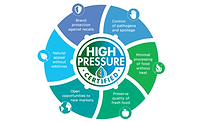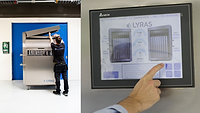High Pressure: Uses for Pasteurization

High hydrostatic pressure technologies are used in numerous applications, from preparing ceramic composites for aircraft, industrial diamond production, pharmaceuticals and cosmetics, and, more recently, for pasteurizing food.
New applications have been discovered for high pressure: inactivating bacterial spores that cause anthrax (Bacillus anthracis) and other pathogenic spores (Clostridium difficile, the notorious microbe of concern in hospitals and nursing care settings).
High pressure is a unique tool for inactivating spores and investigating their mechanisms.
While high pressure is used in commercial equipment (as large as 525 L) to pasteurize refrigerated foods such as juices, meats, seafood products, cold-serve soups and dips, high pressure has not yet been implemented for the production of commercially sterile foods for a combination of reasons.
Food sterilization (done for some military rations, NASA foods, and baby food purées) requires inactivating spores of Clostridium botulinum, which requires high hydrostatic pressures in conjunction with high temperatures.
In an alternative application, we used hydrostatic pressure in combination with moderate temperatures to kill a B. anthracis spore surrogate on self-decontaminating textiles.
High hydrostatic pressure killed the B. anthracis surrogate readily, and high pressure is also chemical-free, so it provided a way to decontaminate textiles without using harsh chemical regimes.”
Interestingly, many studies with high hydrostatic pressure used Bacillus spores as surrogates, which can be quite different from Clostridium species. We recently published a study of the high-pressure germination of C. difficile spores and Clostridium perfringens spores. The results demonstrated some of the differences between Bacillus and Clostridium spores—it was both remarkable and compelling.
The focus of this work presented a simplified, three-step, biochemically plausible “quasi-chemical” germination model (QCGM) for describing bacterial spore germination induced by high pressure processing (HPP) using spores of nonpathogenic Bacillus subtilis, a number of B. subtilis mutant phenotypes, Bacillus amyloliquefaciens spores (pressure surrogate) and C. difficile spores (the notorious hospital pathogen) at different HPP conditions for spore germination via germinant receptors (150 MPa and 37 °C) or through specific protein (SPoVA) channels (550 MPa and 50 °C) with or without prior heat activation of the spores. Spore activation, germination and inactivation can occur concurrently during the pressurization of spore populations that are well known for their heterogeneity. The QCGM has distinct advantages, because it is based on the mathematics of ordinary differential equations and can represent a simplified mechanism of the complex physiology of bacterial spore germination by HPP, including commitment and superdormancy. And since germination is rate determining in spore inactivation by HPP, examples of HPP inactivation kinetics of B. amyloliquefaciens spores were also shown and evaluated using the enhanced quasi-chemical kinetics model. Additionally, micrographs obtained with scanning electron microscopy and transmission electron microscopy of B. amyloliquefaciens spores inactivated by wet heat, chlorine dioxide or HPP were presented and compared. As the understanding of the mechanisms of spore activation, germination and inactivation by HPP continues to grow, mechanistic modeling results such as these will help describe and predict bacterial spore inactivation and support the commercial implementation of HPP under a wide range of pressure and temperature conditions (possibly including sub-sterilization temperatures) for myriad applications in food sterilization of C. botulinum, bio-decontamination of B. anthracis and pharmaceutical sterilization.
We will publish another study soon on spore germination using another nonthermal technology with cross-over potential for textiles: cold plasma. Cold plasma has the potential to eliminate biofilms that degrade textiles or contaminate water lines.
We look forward to continue moving science and technology forward in cross-cutting areas for the benefit of the soldiers in support of Natick’s mission and to know our research is so highly valued scientifically and for its real-world applications at Natick and in the international scientific community.
Christopher J. Doona, Ph.D., is senior research chemist for the U.S. Army – Natick Soldier Research, Development and Engineering Center in Natick, MA.
Florence E. Feeherry, M.Sc., is a research microbiologist for the U.S. Army – Natick Soldier Research, Development and Engineering Center in Natick, MA.
Resources
1. Doona, CJ et al. 2017. “A Quasi-chemical Model for Bacterial Spore Germination Kinetics by High Pressure.” Food Eng Rev 9:1–21.
2. Doona, CJ et al. 2016. “Effects of High Pressure Treatment on Spores of Clostridium Species.” Appl Environ Microbiol 82(17):5287–5297.
3. aem.asm.org/content/early/2016/07/12/AEM.01669-16.full.pdf.
4. Feeherry FE et al. 2016. “Chemical Kinetics for the Microbial Safety of Foods Treated with High Pressure Processing or Hurdles.” Food Eng Rev 8:272.
5. Doona CJ et al. 2015. “Mathematical Models for the Inactivation of Escherichia coli, Listeria monocytogenes, and Bacillus amyloliquefaciens Spores by High Pressure Processing.” Proceedings of the 2015 International Nonthermal Processing Workshop, November 12–13, Athens, Greece.
6. Gulati, D et al. 2015. “Modeling Moisture Migration in Model Multi-Domain Food System: Application to Storage of a Sandwich System.” Food Res Intern 76(3):427–438.
7. Doona CJ et al. 2015. “Fighting Ebola with Novel Spore Decontamination Technologies for the Military.” Front Microbiol 6(663):1–25.
8. Luu S et al. 2015. “The Effects of Heat Activation on Bacillus Spore Germination with Nutrients or under High Pressure, with or without Various Germination Proteins. Appl Environl Microbiol 81(8):2927–2938.
9. Doona CJ. 2014. “Ebola Virus Disease (EVD): Important Aspects for the Food Science and Technology Community.” IUFoST Scientific Information Bulletin, November.
10. Doona CJ et al. 2014. “High Pressure Germination of Bacillus subtilis Spores with Alterations in Levels and Types of Germination Proteins.” J Appl Microbiol 117(3):711–720.
11. Kong L et al. 2014. “Monitoring Rates and Heterogeneity of High Pressure Germination of Bacillus Spores using Phase Contrast Microscopy of Individual Spores.” Appl Environ Microbiol 80:345–353.
12. Perez-Valdespino A et al. 2014. “Properties and Function of the SpoVAEa and SpoVAF Proteins of Bacillus subtilis spores.” J Bacteriol 196(11):2077–2088.
13. Doona CJ et al. 2014. “The PCS, D-FENS, and D-FEND ALL: Novel Chlorine Dioxide Decontamination Technologies for the Military.” JoVE 88:e4354.
Looking for a reprint of this article?
From high-res PDFs to custom plaques, order your copy today!







